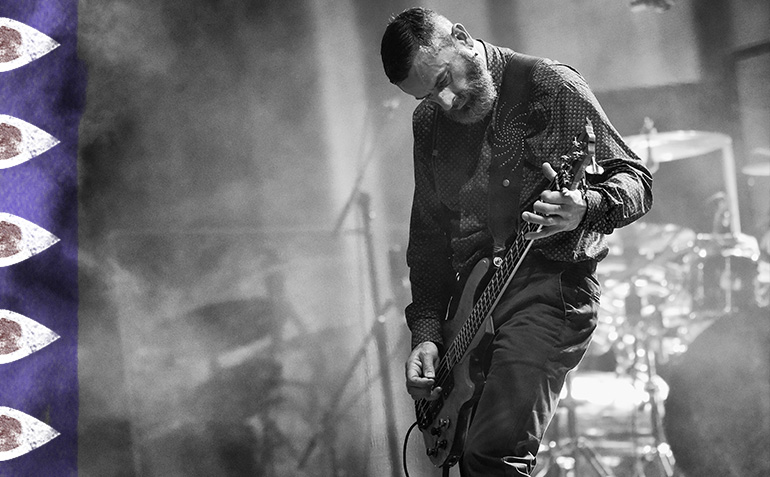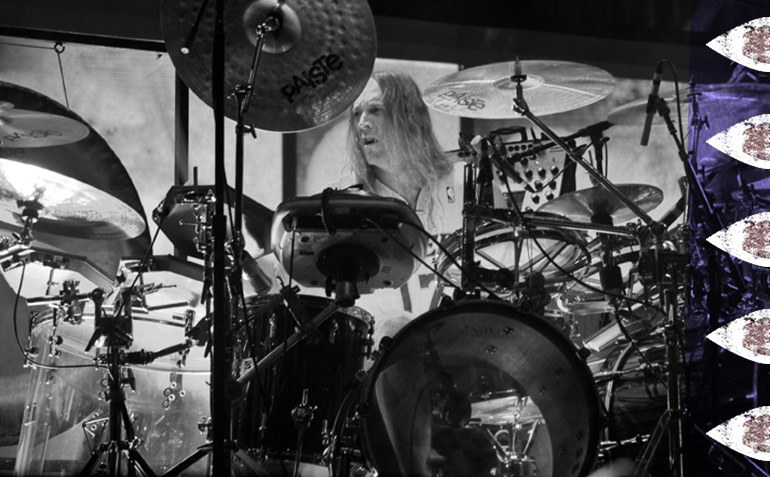Throughout the history of rock 'n' roll, there are only a handful of bands that come to embody a sound and character that is solely theirs. Tool is undoubtedly one of those bands. From their early bombast on "Sober" to the expansive prog of "Third Eye," the band has carved a style that no other band has come close to replicating.
This singular sound originates from how Danny Carey (drums), Justin Chancellor (bass), and Adam Jones (guitar), harness the tones of unique and legendary gear choices to create everything from pummeling metal to mind-bending atmospheres.
Like all of us, the guys have gone through their fair share of gear. But there are some mainstays in each of their arsenals that have become part of the story of the band. So, while celebrating their astoundingly anticipated release, Fear Inoculum, we dug into the vital pieces of gear that helped create the legend.

Guitars
Any discussion of Adam Jones' gear has to start with his iconic Gibson Les Paul Custom Silverbursts. He is known to have a handful of these instruments dating from '78 through '83, which he keeps stock except for swapping in a Seymour Duncan JB in the bridge position. It's a simple and instantly recognizable formula that has followed him throughout his career.
Effects
From his guitars, Jones' signal hits a straightforward pedalboard that belies his expanse of tones. These tonal weapons include an MXR Micro Amp boost and an old DOD FX40B seven-band bass equalizer pedal, both of which are often left on during driven parts to achieve fullness and cut.
Next up are a Boss DD-3 digital delay, a Dunlop 535Q wah, a Heil Talk Box, and a Boss BF-2 flanger heard on everything from the swirling "Stinkfist" to the cutting "Jambi" solo.
Controlling it all are a pair of Boss PSM-5 power supplies and a volume pedal, which he rides for various shades of gain. Though he was known for being a fan of the Ernie Ball VP series of volume pedals in the past, he has since embraced the Goodrich 120.
Amplifiers
As an extremely early adopter of the Diezel VH4, Jones was responsible for carving the amp's third channel grind into the Mt. Rushmore of high-gain tones. In fact, he still tours with his original and exceedingly rare blue-panel version.
Another amp that is just as vital to the Tool sound is his 1976 Marshall Super Bass. By blending this amp with the VH4s, he's able to add that unmistakable British roar that perfectly fills up the middle frequencies. This amp remains bone-stock to this day. And according to Dunlop TV's rundown of Jones' gear, he goes to great lengths to keep it that way.

Basses
The bass chair is the only spot in Tool that has been filled by two people. From the band's early recordings, Opiate and Undertow, Paul D'Amour's Rickenbacker Chris Squire model and Music Man StingRay were laying the tonal groundwork for his successor and current Tool bassist, Justin Chancellor.
While holding tight to the familiar low-end of the band, Chancellor gets there with a couple of Wal MKII basses. (Learn more about Wal and other UK custom bass luthiers here.) These British, boutique instruments offer the power and heft of a StingRay, but thanks to a unique pickup construction, they give Chancellor the cut and presence he needs to punch through the mix.
Effects
While Chancellor uses enough effects to make any guitarist jealous, there are only a handful of pedals that are the cornerstone of his tone. As a bassist who blends clean, dirty, and DI tones, he has long pushed his dirty amp with a combination of a Tech 21 SansAmp GT2 a ProCo Turbo Rat (there are rumblings of a move toward a KHDK Abyss bass overdrive), and a Boss GEB-7 bass equalizer.
And one can't forget the heavy use of his trademark Boss BF-2 flanger and a Boss DD-3 digital delay. Chancellor is a master in utilizing a massive array of effects to achieve maximum impact. But throw these two on your board, and you'll be surprised how many Tool songs await.
Amplifiers
While there is no definitive Tool bass amp, Chancellor has relied on various Mesa Boogie amps and cabinets throughout his entire tenure with the band. The amplifiers have included the 400+, MPulse 600+, and Basis M2000.
During the recording of the band's 10,000 Days, Chancellor made the jump to Gallien Krueger 2001RB heads, which have provided him with his clean and dirty platforms on every tour since. When blended with a squeaky clean Demeter VTBP-201 bass preamp, you have one of the most lauded bass tones in rock history.

Drum Set
Danny Carey settled on his preferred instruments and brands early on, embracing Sonor as his drums of choice. While his set has evolved through the years, according to a 2016 article in Drum! Magazine, Carey has pieced together a mammoth set unlike any other, including his Sonor Danny Carey Signature 8"x14" snare, bass drums cast from melted cymbals, and a Sonor custom-made acrylic gong drum.
Electronics
Carey is also big on blending acoustic and electronic percussion. His go-to pads remain his prototype Mandalas that he uses in conjunction with Native Instruments' Battery software. You'll also find him pulling everything from world percussion to ambient effects from an old-model Korg Wavedrum and the newer Roland Handsonic, which are often called on for the band's early material.
Cymbals and Sticks
For cymbals, Carey has been a die-hard supporter of Paiste cymbals since 1992. Here is a list of his current setup, pulled directly from Carey's Paiste artist page:
Of course, the most crucial part of the whole setup, other than Carey himself is his Vic Firth Danny Carey signature sticks. These teardrop-tipped hickory sticks feature a beveled midsection that helps heavy hitters like Carey pull off his astounding technique while never losing control.
